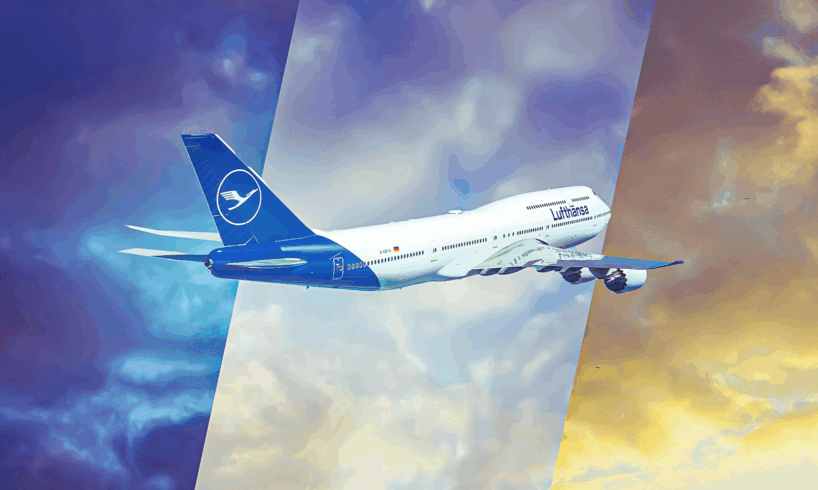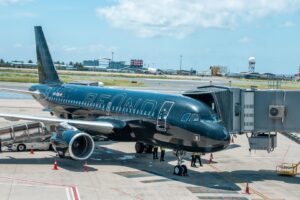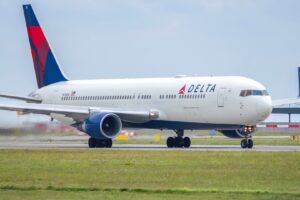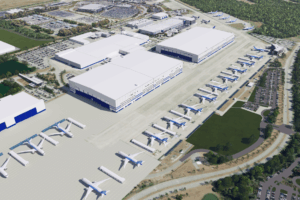
German carrier Lufthansa has been flying to all corners of the globe for decades, connecting Europe to countries as far as Argentina, Australia, Japan and South Africa, to name a few. In fact, the airline is the seventh-largest in the world as measured by number of destinations served at over 210, a vast network served by Lufthansa’s fleet of over 300 aircraft.
Lufthansa
IATA/ICAO Code
LH/DLH
Year Founded
1953
Looking at data from aviation analytics company Cirium, the carrier currently flies to 63 airports outside of Europe. These routes vary in length, ranging from a 900-mile flight to Tunisia to a 7,100-mile service to Argentina. A recent post by AeroRoutes shows Lufthansa’s intercontinental network from the summer season 30 years ago, revealing some interesting changes and route evolutions over the years.
Inside Lufthansa’s Intercontinental Network Today
Photo: Vincenzo Pace | Simple Flying
With one of the world’s most interesting long-haul fleets featuring both the Boeing 747 and Airbus A380, along with the newer Boeing 787 Dreamliner and Airbus A350 (and the Boeing 777X also coming soon!), Lufthansa is also one of the world’s biggest airlines by number of countries served (74).
This shows in the carrier’s extensive range of international connections, which sees it fly to Africa, Asia, the Middle East and the Americas. The table below shows all non-European destinations flown to by Lufthansa out of its Frankfurt and Munich hubs.
Continent
Destinations
Africa
Abuja, Algiers, Cairo, Cape Town, Casablanca, Johannesburg, Lagos, Luanda, Malabo, Nairobi, Port Harcourt, Tunis
Asia
Almaty, Amman, Astana, Baku, Bangkok, Bengaluru, Beijing, Chennai, Delhi, Dubai, Hong Kong, Hyderabad, Mumbai, Osaka, Seoul, Shanghai, Singapore, Tehran, Tokyo, Yerevan
North America
Atlanta, Austin, Boston, Charlotte, Chicago, Dallas/Fort Worth, Denver, Detroit, Houston, Los Angeles, Miami, Mexico City, Montreal, New York (JFK), Newark, Raleigh/Durham, St Louis, San Diego, San Francisco, San Jose (CR), Seattle, Toronto, Vancouver, Washington-Dulles
South America
Bogotá, Buenos Aires, Rio de Janeiro, São Paulo
Middle East
Dammam, Riyadh, Tel Aviv
It’s important to note that a few of these destinations are part of a triangle routing:
Abuja to Port Harcourt
Almaty to Astana (and back)
Lagos to Malabo
Riyadh to Dammam
The longest route operated by Lufthansa this summer is its Frankfurt-Buenos Aires connection at over 7,000 miles, a route that sees daily service with the airline’s Boeing 747-8i fleet. Other notable lengthy routes include connections to Singapore and Mexico City, demonstrating the carrier’s huge global reach.
Related
The World’s 10 Longest Nonstop Boeing 747 Routes
Lufthansa dominates the list with seven of the ten longest passenger 747 routes in April.
Lufthansa’s Intercontinental Network In 1995
Photo: Vytautas Kielaitis | Shutterstock
Lufthansa’s intercontinental network exactly three decades ago was almost as extensive as it is today in terms of destination count, but there are some other major differences with its network today. The first thing to note is that the number of airports served was fewer at 56 destinations, down from 63, although its longest route was further with its one-stop service to Sydney via Bangkok.
Continent
Destinations
Africa
Abidjan, Accra, Cairo, Cape Town, Dar es Salaam, Harare, Johannesburg, Lagos, Nairobi, Tunis, Tripoli, Windhoek
Asia
Bangkok, Beijing, Bombay, Delhi, Guam, Hong Kong, Karachi, Kuala Lumpur, Madras, Manila, Nagoya, Osaka, Shanghai, Singapore, Taipei, Tokyo
North America
Atlanta, Boston, Chicago, Dallas, Los Angeles, Miami, Montreal, Mexico City, New York, Newark, San Francisco, Toronto, Vancouver, Washington D.C.
South America
Bogotá, Buenos Aires, Caracas, Lima, Rio de Janeiro, Santiago, São Paulo
Middle East
Bahrain, Dubai, Jeddah, Kuwait, Riyadh, Tel Aviv
Oceania
Sydney
In 1995, Lufthansa’s widebody fleet was considerably different from today. While it still flies the 747-400 today as it did back then, Lufthansa was also still flying the 747-200, the Airbus A340 and A300, and even had a couple of McDonnell Douglas DC-10s left in its fleet.
What’s Changed In 30 Years?
Photo: Wenjie Zheng | Shutterstock
Lufthansa has dropped several destinations from its network since 1995 and added a similar number of new destinations, transforming the look of its network today compared to three decades ago. In fact, there are 20 destinations that Lufthansa flew to in 1995 that it no longer serves today:
South America: Caracas, Lima, Santiago
Africa: Abidjan, Accra, Dar es Salaam, Harare, Tripoli, Windhoek
Asia: Guam, Karachi, Kuala Lumpur, Manila, Nagoya, Taipei
Middle East: Bahrain, Dubai, Jeddah, Kuwait
Oceania: Sydney
The data also shows there has been a major expansion of Lufthansa’s North American reach in the last few decades. Back in 1995, Lufthansa flew to 14 destinations (ten in the US, three in Canada, one in Mexico), but this has grown to 24 destinations today thanks to the additions of nine more US cities in Austin, Charlotte, Denver, Detroit, Houston, Raleigh/Durham, St. Louis, San Diego and Seattle, plus San Jose in Costa Rica.
Lufthansa hasn’t just expanded its presence in the US, with the airline adding a handful of cities in both Africa and Asia to make up for the services it has dropped. Today, there are 27 destinations that Lufthansa flies to that it didn’t back in 1995:
North America: Austin, Charlotte, Denver, Detroit, Houston, Raleigh/Durham, Saint Louis, San Diego, San Jose (CR), Seattle
Africa: Abuja, Algiers, Casablanca, Luanda, Malabo, Port Harcourt
Asia: Almaty, Amman, Astana, Baku, Bengaluru, Dubai, Hyderabad, Seoul, Tehran, Yerevan
Middle East: Dammam
Perhaps another important point to note is that Star Alliance
, of which Lufthansa was a founding member, had not been created in 1995. Lufthansa’s codeshare partnerships with fellow Star Alliance carriers have been important for its international reach, allowing its customers to seamlessly connect to different flights at many of Lufthansa’s highest-profile international destinations.
Busiest Intercontinental Routes This Summer
Photo: Vincenzo Pace | Simple Flying
The majority of Lufthansa’s intercontinental routes run with a daily flight, but there are some routes requiring additional frequencies due to high demand. Cirium data shows that Lufthansa’s busiest intercontinental routes (as measured in flight frequencies) this summer will be four routes benefiting from double daily flights:
Route
Flights (monthly)
Aircraft Type
Frankfurt-Boston Logan
62
A340, B747
Frankfurt-Chicago O’Hare
62
A340
Frankfurt-New York JFK
62
A340, B747
Munich-Tel Aviv
62
A321neo
If we are looking at the busiest flights by seat capacity, the two Frankfurt routes to Boston and New York come out on top with a total of 20,150 seats each way in May. Lufthansa currently operates just one daily roundtrip to Boston this month, but will be returning the 747 to Boston come May 1st as part of a double-daily schedule.
Other high-capacity routes out of Frankfurt include services to Los Angeles, Washington Dulles, Cairo, Shanghai and Tunis. From Munich, its double-daily to Tel Aviv will be the busiest route, followed by flights to Chicago operating 12 times per week this May.
Lufthansa’s Largest Long-Haul Hub
Photo: Philip Lange | Shutterstock
Frankfurt Airport
is Lufthansa’s main base for long-haul operations, originating more than half of the airline’s intercontinental network. This summer, Lufthansa will serve 58 non-European destinations out of Frankfurt, amounting to over 1,700 flights and almost half a million seats each way per month.
Frankfurt is the home of Lufthansa’s Boeing 747-8 fleet, of which it is the world’s largest operator with a total of 19 airframes.
As for Munich Airport
, the airport is notably the base of Lufthansa’s reactivated Airbus A380 fleet, which will be busy operating flights to the likes of Bangkok, New York, Los Angeles and Washington.
Related
Why Doesn’t Lufthansa Fly The Airbus A380 From Its Frankfurt Hub?
Deployment of the once Covid-stricken aircraft appears to be based on fleet strategy.
Lufthansa’s Long-Haul Fleet
Photo: Lufthansa
Lufthansa is in the process of transforming its long-haul fleet, which presently includes both older models like the A340 and 747-400 alongside modern widebodies in the 787 Dreamliner and A350. The biggest change will be the arrival of the Boeing 777X, with Lufthansa scheduled to be the launch customer of the new widebody sometime in 2026.
While its 787 Dreamliner fleet has remained the same size for almost two years, Lufthansa has many more airframes on order due for delivery in the coming years. The carrier has a total of 29 787s on order and expects a few deliveries this year; however, the airframes have remained stuck at the factory due to certification complications with its new Allegris seats.
Aircraft Type
Total
Average Age
Airbus A340-300
16
25.5 Years
Airbus A340-600
8
18 Years
Airbus A350-900
30
5 Years
Airbus A380-800
8
13.0 Years
Boeing 747-400
8
25.0 Years
Boeing 747-8
19
11.5 Years
Boeing 787-9
5
5 Years
As for the airline’s older aircraft, it has already confirmed its A340-600 fleet will stop flying at the end of the summer season. This is an acceleration of Lufthansa’s initial timeline for the A340-600s removal, which was due to happen by 2028. This date remains in place for its 747-400s, which will be approaching 30 years old by the time they are retired, as will its A340-300s.






